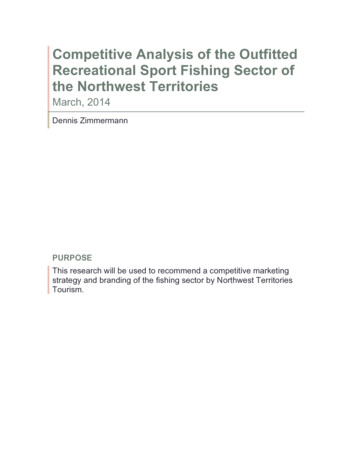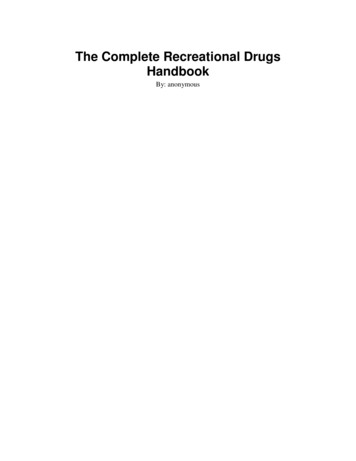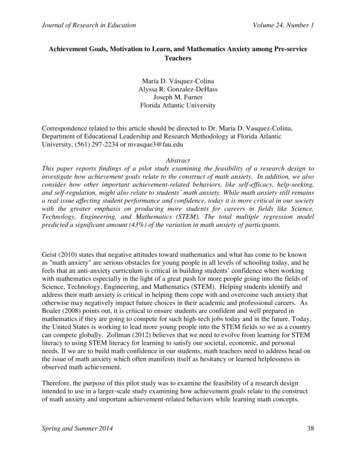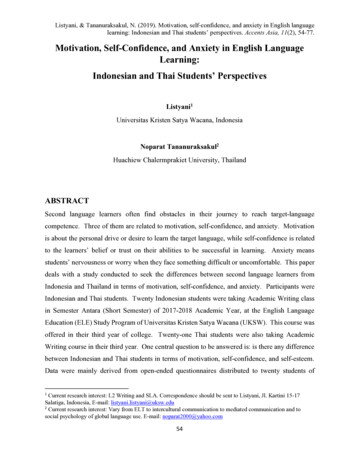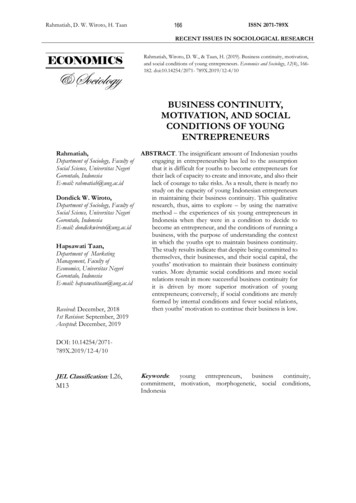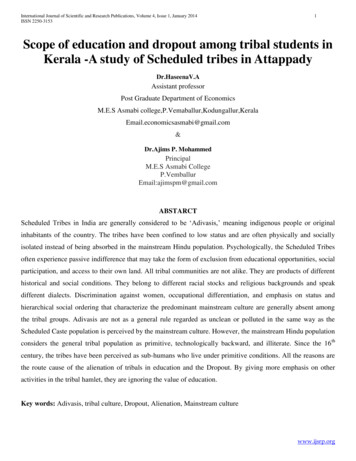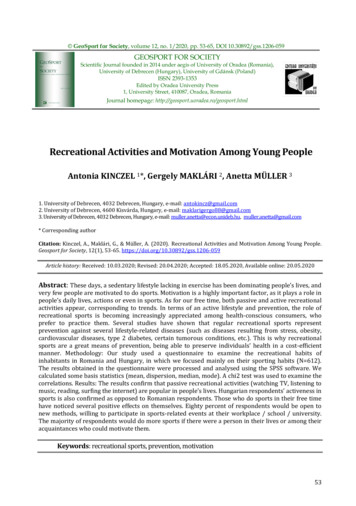
Transcription
GeoSport for Society, volume 12, no. 1/2020, pp. 53-65, DOI 10.30892/gss.1206-059GEOSPORT FOR SOCIETYScientific Journal founded in 2014 under aegis of University of Oradea (Romania),University of Debrecen (Hungary), University of Gdánsk (Poland)ISSN 2393-1353Edited by Oradea University Press1, University Street, 410087, Oradea, RomaniaJournal homepage: al Activities and Motivation Among Young PeopleAntonia KINCZEL 1*, Gergely MAKLÁRI 2, Anetta MÜLLER 31. University of Debrecen, 4032 Debrecen, Hungary, e-mail: antokincz@gmail.com2. University of Debrecen, 4600 Kisvárda, Hungary, e-mail: maklarigergo88@gmail.com3. University of Debrecen, 4032 Debrecen, Hungary, e-mail: muller.anetta@econ.unideb.hu, muller.anetta@gmail.com* Corresponding authorCitation: Kinczel, A., Maklári, G., & Müller, A. (2020). Recreational Activities and Motivation Among Young People.Geosport for Society, 12(1), 53-65. https://doi.org/10.30892/gss.1206-059Article history: Received: 10.03.2020; Revised: 20.04.2020; Accepted: 18.05.2020, Available online: 20.05.2020Abstract: These days, a sedentary lifestyle lacking in exercise has been dominating people’s lives, andvery few people are motivated to do sports. Motivation is a highly important factor, as it plays a role inpeople’s daily lives, actions or even in sports. As for our free time, both passive and active recreationalactivities appear, corresponding to trends. In terms of an active lifestyle and prevention, the role ofrecreational sports is becoming increasingly appreciated among health-conscious consumers, whoprefer to practice them. Several studies have shown that regular recreational sports representprevention against several lifestyle-related diseases (such as diseases resulting from stress, obesity,cardiovascular diseases, type 2 diabetes, certain tumorous conditions, etc.). This is why recreationalsports are a great means of prevention, being able to preserve individuals’ health in a cost-efficientmanner. Methodology: Our study used a questionnaire to examine the recreational habits ofinhabitants in Romania and Hungary, in which we focused mainly on their sporting habits (N 612).The results obtained in the questionnaire were processed and analysed using the SPSS software. Wecalculated some basis statistics (mean, dispersion, median, mode). A chi2 test was used to examine thecorrelations. Results: The results confirm that passive recreational activities (watching TV, listening tomusic, reading, surfing the internet) are popular in people’s lives. Hungarian respondents’ activeness insports is also confirmed as opposed to Romanian respondents. Those who do sports in their free timehave noticed several positive effects on themselves. Eighty percent of respondents would be open tonew methods, willing to participate in sports-related events at their workplace / school / university.The majority of respondents would do more sports if there were a person in their lives or among theiracquaintances who could motivate them.Keywords: recreational sports, prevention, motivation53
Antonia KINCZEL, Gergely MAKLÁRI, Anetta MÜLLERDOI 10.30892/gss.1206-059IntroductionRecreational sports have many known positive effects on a person’s physical,mental, and social well-being, which has been confirmed by several Hungarian (Apor,2011; Juhász et al., 2015; Müller and Bácsné, 2018; Simon et al., 2018) andinternational (Dobay et al., 2017; Bendíková et al., 2018; Baidog and Herman, 2018;Erdely et al., 2020) literature sources. Nowadays, stress and stress-related diseasesprevail because people’s lives are characterized by performance and work pressure(Dajnoki et al., 2018; Héder et al., 2018; Dajnoki et al., 2019), which is accompanied byhigh stress levels. This is why those recreational activities have become increasinglypopular that are able to reduce stress levels, such as massage (Bíró et al., 2019) orcertain exercise programs (Csörgő et al., 2013; Bodolai et al., 2016; Molnár, 2019). Anincreasingly greater part of society is affected by various lifestyle-related diseases likestress, anxiety, obesity, stroke, hypertension, cardiac diseases, various bad posturesand deformities, which could be reduced by increased recreational sports and physicalactivity (Ding et al., 2017; Iski and Rurik, 2014). Sport as a “medicine of exercise”teaches a lot of things and helps to develop many positive personality traits such asperseverance, selflessness, the ability to come to terms with successes and failures,fatigue tolerance, a realistic self-esteem, tolerance, while at the same time it improveswill power, socialization, the development of social relations and courage. In manypeople’s lives, sport provides the motivation to perform other tasks, as well. Activeexercise could reduce the risk of the subsequent development of several diseases(Bíró, 2018). Many people die both in Hungary and Europe from cardiovasculardiseases, tumorous diseases, early coronary artery diseases or suicide, which could beprevented by sport.Many people are aware of the positive effects of sport, but they still prefer tospend their free time on passive recreational activities (Czabai et al., 2007; Kovács,2011; Horkay et al., 2018a). Because we are overloaded, we usually do not have themood or motivation to do sports after a long and hard day. Several studies haveexamined sporting habits among university students (Murányi, 2010; Kovács, 2016;Fenyves et al., 2019). Children are so engaged by the world or smartphones and theinternet that they spend less and less time outdoors, do less exercise, while theirpersonality also changes in a negative direction. Research on recreational habits drawsattention to the trends affecting leisure consumption (Gődény et al., 2018; Horkay et al.,2018b; Fenyves et al., 2018; Gősi et al., 2019; Bácsné Bába et al., 2018a, b, c). Recreationis still strongly dominated by passive leisure activities (watching TV, reading, surfing theinternet, listening to music), which is also confirmed by our research.If we are able to increase people’s active physical exercise and provide sufficientmotivation for them, several diseases could be prevented. It is a huge problem in54
Recreational Activities and Motivation Among Young Peoplevol. 12, no. 1, 2020, pp. 53-65health education that people are unable to imagine the experience of a disease or therisk of even a serious damage to health (Dajnoki, 2011, 2014, 2015) during the periodwhen they could still do the most about it, when it is not too late to change theirlifestyle (Buda, 1994). We need to build a society that consciously plays sports andpays attention to its health.MethodologyTo examine the spending of free time and the presence of motivation, wedesigned a questionnaire-based research, in which we included questions regardingthe system of recreational preference and motivational tools of the persons involvedin the study. Regarding recreational habits, we also examined the frequency of theactive and passive forms of activity, as well as the positive changes participants feltafter doing sports. We also asked how they would act or feel if there were more sportsopportunities at the workplace / school / university, what kind of lectures they wouldlike to attend, and who motivating factors are for them.65% of respondents were female and 35% were male. 64.4% live in Hungary,while 35.6% in Romania. Table 1 show that there were more male respondents inRomania than in Hungary.68.1% of respondents were aged 19–25, 13.1% were under 18, and the rest(18.8%) were above 26 years of age (table 2).Table 1. Proportion of men and women according to countryMaleYour gender:FemaleTotalNo.%No.%No.%In which country do you ble 2. Breakdown by ageValid 1819-2526-3031-3536-4041-4546-5051-5556 14.43.32.52.32.02.61.8100.0Valid e Percent13.181.285.688.991.393.695.698.2100.055
Antonia KINCZEL, Gergely MAKLÁRI, Anetta MÜLLERDOI 10.30892/gss.1206-059In order to be able to find a correlation between spending their free time andtheir work, first we asked respondents what kind of work they do. 70.9% arestudents, i.e. do sedentary work, 10.6% are not students but do sedentary work,5.6% do physical work, while 12.9% do mixed (physical and sedentary) work. Wemight think that since many people lead a sedentary lifestyle, they do a lot ofsports in their free time to be able to balance their lifestyle. Unfortunately, we arewrong. Most people still spend their free time with passive recreational activities.The world of media is immensely popular, also confirmed by our research, as67.5% of respondents spend their free time with surfing the internet (on acomputer, smartphone or tablet). The second most popular spare-time activityalso belongs to passive recreation, as 62.7% of respondents watch TV or listens tomusic to relax from fatigue and try to recharge. This is followed by activerecreational activity; 49.5% of respondents do sports in their free time. 46.9% liketo spend their spare time in bed with passive rest and lazing around. Our researchis in line with other Hungarian research findings where samples of young adultsare also dominated by passive recreational activities (Müller et al., 2011; Mosonyiet al., 2013; Boda et al., 2015; Boda et al., 2019; Laoues et al., 2019). Other popularfree-time activities include reading or meditation (40.7%), housework (cleaning,cooking, doing the laundry, emptying the bins, gardening, etc.) (38.2%), walkingand playing with a pet (32.2%), studying (25.5%) and shopping (22.9%), whileless popular activities include attending sports events as a spectator (20.9%),religious activities, going to church, attending diocesan programs, religiouseducation, etc. (16.8%), health preservation (sauna, spa) (13.2%), playing music(8.8%), fishing (5.7%) and hunting (1.3%). Several studies confirm the increasedappreciation of and demand for meditation and spirituality (Lengyel, 2016, 2019).Respondents do not always do the same free-time activities, they could choosemore than one answer, which is the reason of the above percentages. These figuresshow that although 81.5% of the people do sedentary work or both sedentary andphysical work, they still spend little time with more active recreational activities. Itis understandable that those who do physical work prefer to read, relax, or listento music in their free time.Sports68.3% of respondents do some exercise outside of their physical education classof duration of at least thirty minutes. This value is better than what was publishedearlier in a 2018 Eurobarometer study on Hungarian data, which found that in the EU,only 7% of the population do sports five or more times a week, 33% one to four times56
Recreational Activities and Motivation Among Young Peoplevol. 12, no. 1, 2020, pp. 53-65a week, while 14% even more rarely. In the study, 46% was the proportion of adultswho never engage in regular sporting activities (Eurobarometer, 2018).91.3% of respondents are aware of the sporting opportunities in theirenvironment (clubs, outdoor and indoor gyms, etc.), but still few of them go tothese places.Table 3. Are they aware of sporting opportunities?Are you aware of the sportingopportunitiesinyourenvironment (clubs, outdoorand indoor gyms, etc.)?TotalYesNoCount% within In which country doyou live?Count% within In which country doyou live?Count% within In which country doyou live?In which country do you 218100.0%100.0%The most popular sports that people nowadays like to do include fitness(Gődény et al., 2018; Müller et al., 2019), running, swimming, Zumba, aerobics,football (Bácsné Bába et al., 2018b; Balogh et al., 2019), while less popular sportsinclude basketball, tennis, and handball. These statements are also supported by ourresearch. Most people prefer walking, hiking, Nordic walking, running, cycling, orgoing to fitness workouts. The least popular sports among respondents are icehockey, golf, chess, archery, tennis, and fencing.Note that those sports are more popular that can be done outdoors, in thenature, or even while going to school / university / work. Natural sports alsoplay an important role in skill development and stress relief (Borbély-Müller,2015). 21.7% of respondents like to do their exercise outdoors, in parks. Theycan thus devote themselves to nature and better wind down. 20% do sports athome, possibly because they do not like to go out, and this is a cost-efficientmethod. Since fitness is one of the popular sports, it is obvious that many peoplego to fitness and wellness centres to do sports. Several people do not do sportsbecause they do not have enough spare time, so many of them do sports on theirway to school / work / university. 15.7% do sports in an association or club.Respondents mainly do sports to preserve their health and general well-being(292), but at the same time, sports make them happy (245), and furthermore, to loseweight or improve their appearance (218), but many respondents selected the“exciting and entertaining activity” option (180) as well. Very few of them do sportsbecause others expect them to do so (18).57
Antonia KINCZEL, Gergely MAKLÁRI, Anetta MÜLLERDOI 10.30892/gss.1206-059Table 4. Why do you do sports? (scale 1–7)To preserve my health andgeneral well-being.To spend time with othersTo improve my appearance, tolose weight.It makes me happy.I can get to know myself andmy boundaries.It is an exciting, entertainingactivity.Because of others; it isexpected from me.NMinimumMaximumMeanStd. igure 1. Positive changes after doing sportsFigure 2. What are people doing sports like?58
Recreational Activities and Motivation Among Young Peoplevol. 12, no. 1, 2020, pp. 53-65458 people claimed that they had opportunities to do the sport they like. 115people claimed that they would have the opportunity, but they did not haveenough free time to do the active exercise. In addition, 56 people cannot afford todo sports they like.The majority of respondents like to do sports alone (386), while 287 of themprefer to do active exercise with their friends, and 262 in a team. 87 respondents dosports within a club, 37 with a trainer. This may be due to the fact that several trainershave not yet been able to establish a close relationship with their competitors.If the university / school / workplace organized various sports days, 80.6% ofrespondents would attend them. They think such events would be goodentertainment opportunities, they would strengthen relationships, help them relax,improve the community, and people would be healthier and could recharge. It wouldbe an effective method if the various companies held as many sports days aspossible to get workers to do some exercise, which would result in a positive effect,as people would perform their work much more actively in the same amount of time(Hidvégi et al., 2017).People who have already done sports felt refreshed afterwards, their mood wasbetter, they had more positive thoughts, learning was much more efficient aftersports, and they could focus better on the tasks ahead.According to the respondents, people who do sports are healthier, their mood isbetter, they are prettier, more organised, they can perform better in their work, andthey can better dispose of their time.MotivationThe term ‘motivation’ is used to describe the psychological process underlyingany behaviour (Gage and Berliner, 1991; Nagy, 2000); nevertheless, the detaileddescription of this process is rarely attempted, which is obviously related to thecomplexity of the phenomenon of motivation (Józsa, 2007).Motivation as an umbrella term consists of various motives. It determines thedegree of activity of the body, the organisation and effectiveness of behaviour, andalso includes all the internal factors that encourage actions or behaviours. The internalurge that affects an individual can be of different origins. It is called a need if thesources of the stimulus are biological motives (hunger, lack of oxygen, etc.); however,if the internal urge is of a psychological origin, we speak about drive (Freud’s“instinct”), which is a kind of psychological driving force to achieve an individual’s setgoals or an organization’s internal state of equilibrium or so-called “homeostasis”.There are, however, motivational “channels” that are unique to the human race. Wecan distinguish two types. One is “intrinsic” motivation where the stimulus for actionis the inherent enjoyment in the act itself. The other group of human motivation is59
Antonia KINCZEL, Gergely MAKLÁRI, Anetta MÜLLERDOI 10.30892/gss.1206-059“extrinsic” or performance-driven motivation where the urge comes from theachievement of a goal (e.g. breaking out of poverty) or an external factor (Lenténé,2014, 2017). These can appear in various forms in the different areas of life.The presence of adequate motivation is particularly important for sports(Fyodorov et al., 2019; Bendíková and Dobay, 2017; Kozma et. al., 2015; Tătar et. al.,2018; Buhaș-Stance, 2017). Many people do not do sports because they are notmotivated. We asked respondents who had motivated them to start to do sports. 518of them started to do sports on their own initiative. 176 people were encouraged byfriends, while 148 of them by parents. Few of them were motivated by siblings,teachers, trainers, or doctors. There should be an increase in the number of parentsmotivating children to do sports, as several studies discuss the determining role of thefamily or parent (Laoues, 2019; Mező and Mező, 2017; Herpainé, 2018; Kőnig-Göröghet al., 2019). The more parents do active physical exercise, the more children would beinvolved in the world of sports.Figure 3. Who motivated them to do sports?Motivation is essential in sports, since it affects all factors that influenceperformance: these include physical fitness, technical and tactical training, mentalpreparation, as well as everyday lifestyle. Respondents are aware of the positiveeffects of sport, and probably that is why they responded that if they have or will havechildren, they would motivate them to do sports (99.5%).Most people have found the person with whom they would like to train, as78.6% of respondents replied that there is a person in their environment whom theycould ask to motivate them to do sports, or if this person invited them to do sports,they would gladly join them.60
Recreational Activities and Motivation Among Young Peoplevol. 12, no. 1, 2020, pp. 53-65People are interested in many topics. We asked what kind of lectures theywould like to attend. 292 respondents are interested in the topic of the appropriatetrainings and losing weight, 287 would participate in personality developmenttrainings, 276 in motivational lectures, and 252 people would be attracted most tolectures on healthy eating.Of the experience of correlation analysisSporting activity of Hungarians was higher than that of Romanians, as 71.6% ofHungarian respondents (282 people), while 62.4% of Romanians (136 people)claimed that they do sports (defined as doing recreational sports at least once a week,at least for 30 minutes). The chi2 test also confirmed the higher sporting activity ofHungarians (chi2 5.473, df 1, p 0.013).A significant difference was found between Hungarian and Romanianrespondents also regarding the frequency of doing sports (chi2 13.521, df 5,p 0.019). There are more Hungarians who do sports as frequently as 2–3 or 3–5hours a week, and there are fewer people among them who do not do sports at all,compared to Romanians (table 5).Table 5. How much sports do you do?RomanianI do sports f
Recreational Activities and Motivation Among Young People vol. 12, no. 1, 2020, pp. 53-65 57 a week, while 14% even mo
